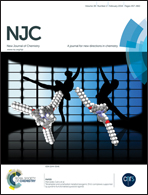Structure and properties of metal complexes of a pyridine based oxazolidinone synthesized by atmospheric CO2 fixation†
Abstract
We present here the synthesis of a pyridine containing oxazolidinone, 3-(pyridin-2-ylmethyl)oxazolidin-2-one (L) through the fixation of atmospheric CO2 and without any added base. L has been used to generate three metal complexes [Cu(L)2(ClO4)2] (1), trans-[Pt(L)(DMSO)Cl2] (2), and trans-[Pd(L)2Cl2] (3). Complexes 1–3 have been structurally characterized using single crystal X-ray diffraction and other analytical techniques. The activity studies of the three metal complexes show that the CuII complex, 1, is more cytotoxic against the MCF-7 cancer cell line (IC50 = 114 ± 2 μM) as compared to a non-carcinogenic mouse fibroblast (NIH 3T3) (IC50 = 198 ± 1 μM). The PtII complex, 2, is the most toxic among the three complexes against both human breast adenocarcinoma (MCF-7) (IC50 = 102 ± 2 μM) and the human lung adenocarcinoma epithelial cell line (A549) (IC50 = 198 ± 2 μM), whereas the PdII complex, 3, is found to be an effective first generation oxazolidinone based PdII catalyst, for the Suzuki–Miyaura cross coupling of aryl halides and phenylboronic acids in aerobic conditions, both in a conventional heating method, as well as a microwave method. The results show that although PtII and CuII were also complexed with oxazolidinone, PdII seems to be the most likely choice of metal when it comes to C–C bond coupling via C–X bond activation.


 Please wait while we load your content...
Please wait while we load your content...